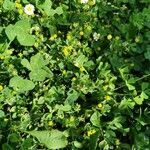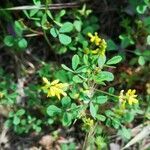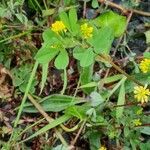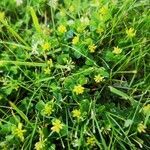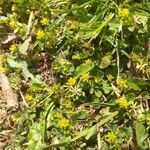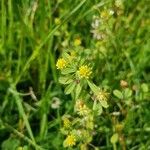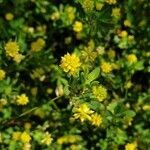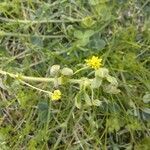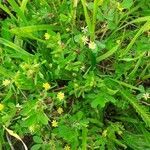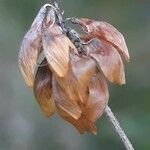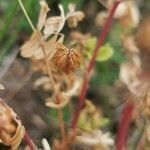Annual; stems sparsely to densely hairy, procumbent or ascending, not rooting at nodes. Lvs glabrous to moderately hairy on petioles and undersurface of leaflets; petioles 1-5-(20) mm long; leaflets obovate, usually emarginate, occasionally obtuse, rarely some leaflets shortly mucronate, cuneate at base, finely serrate, c. 3-12 mm long; lateral veins thin and straight to leaflet margin; petiolules distinctly unequal on most lvs; lateral petiolules < 1 mm long; terminal petiolule up to 2-(3) mm long; stipules ovate, acute. Infls axillary, racemose, cylindric to globose, pedunculate, much > lvs; fls 5-20-(25); pedicels 0-1 mm long; bracts subtending fls reduced to glandular hairs. Calyx ± glabrous, occasionally sparsely hairy, 5-veined, not inflated at fruiting; throat open, glabrous; calyx teeth unequal, < corolla, erect at fruiting; 3 lower teeth longer, lanceolate, ± = or somewhat > tube; 2 upper teeth triangular and < tube; sinuses obtuse. Corolla yellow, persistent, 2.5-4 mm long. Pod glabrous, straight, > calyx, 2-3 mm long, 1-seeded; seeds c. 1-1.5 mm diam.
Annual herbs, glabrous to sparsely pubescent. Stems erect to decumbent, (5-)10-30(-40) cm. Leaves pinnately 3-foliolate; stipules obliquely ovate, 4-8 mm, base rounded, margins finely dentate, apex acute; petiole shorter than or equal to leaflets; terminal petiolule longer than lateral petioles; leaflets obovate, 5-10(-12) × 3-8 mm, veins 6-8 pairs, base cuneate, margins entire proximally, obscurely serrulate distally, apex rounded or emarginate. Flowers 5-15, in axillary heads; peduncle 0.5-3(-4) cm, pubescent; pedicels less than 1 mm, after flowering pendulous. Calyx ca. 2 mm, veins 5. Corolla pale yellow, turning brown, 3-4 mm; standard narrowly boat-shaped, smooth, apex acute. Legume oblong, 1.5-2 mm, shortly beaked; stipe ca. 1 mm. Seed 1, pale brown, globose. Fl. and fr. Apr-Sep.
Annual herb, 0.2-0.4 m high. stems many, brownish, erect to ascending, poorly branched. Leaves very short petioled. Leaflets 8-10 x 4-7 mm, obovate, base cuneate, apex slightly notched, dentate around upper part, bluish green. Stipules herbaceous, ovate, acute. Inflorescences: heads 8-9 x 6-7 mm, 3-20-flowered, hemispherical; peduncles axillary, filiform. Flowers yellow, becoming brownish in fruit; conduplicate with funnelshaped bundle of nerves in each half. Calyx with campanulate tube. Petals: standard ovate. Flowering time Jan.? Pod 1-seeded, stipitate, persistent style ± 1/3 length of pod.
Much like no. 16 [Trifolium campestre Schreb.]; stalk of the terminal lfl scarcely 1 mm; heads smaller, 5–10 mm, commonly with 5–15 fls each 2.5–3.5 mm; standard inconspicuously veined; 2n=28, 32. Native of Europe, established as a weed in waste ground throughout much of N. Amer. Summer.

